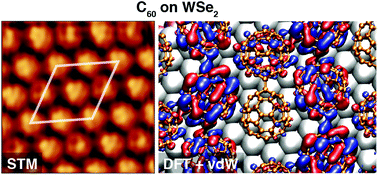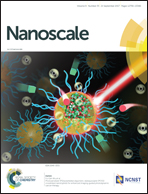Rotational superstructure in van der Waals heterostructure of self-assembled C60 monolayer on the WSe2 surface†
Abstract
Hybrid van der Waals (vdW) heterostructures composed of two-dimensional (2D) layered materials and self-assembled organic molecules are promising systems for electronic and optoelectronic applications with enhanced properties and performance. Control of molecular assembly is therefore paramount to fundamentally understand the nucleation, ordering, alignment, and electronic interaction of organic molecules with 2D materials. Here, we report the formation and detailed study of highly ordered, crystalline monolayers of C60 molecules self-assembled on the surface of WSe2 in well-ordered arrays with large grain sizes (∼5 μm). Using high-resolution scanning tunneling microscopy (STM), we observe a periodic 2 × 2 superstructure in the C60 monolayer and identify four distinct molecular appearances. Using vdW-corrected ab initio density functional theory (DFT) simulations, we determine that the interplay between vdW and Coulomb interactions as well as adsorbate–adsorbate and adsorbate–substrate interactions results in specific rotational arrangements of the molecules forming the superstructure. The orbital ordering through the relative positions of bonds in adjacent molecules creates a charge redistribution that links the molecule units in a long-range network. This rotational superstructure extends throughout the self-assembled monolayer and opens a pathway towards engineering aligned hybrid organic/inorganic vdW heterostructures with 2D layered materials in a precise and controlled way.

- This article is part of the themed collection: Editor’s Choice: van der Waals heterostructures


 Please wait while we load your content...
Please wait while we load your content...